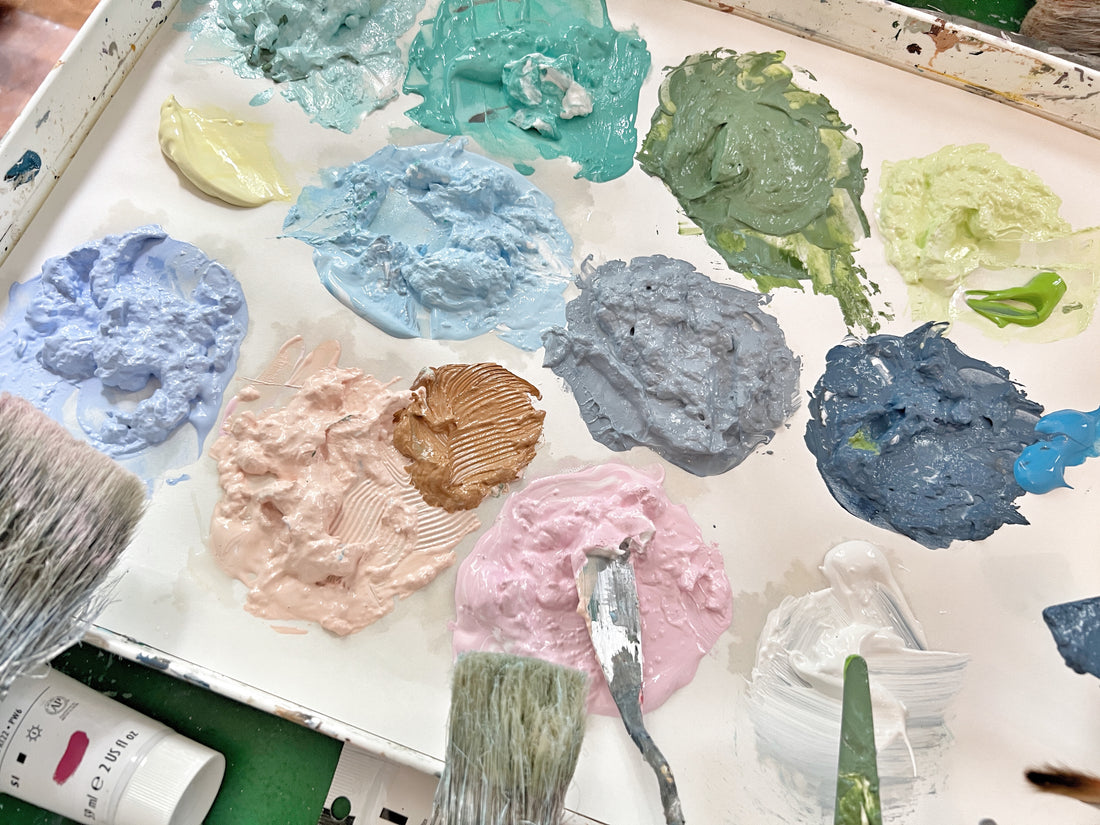Have you ever wondered why an artist charges a specific amount for an original painting? Contrary to popular belief, the price tag is not arbitrary. In this blog post, we'll delve into the various factors that contribute to the pricing of original artwork and shed light on the behind-the-scenes aspects that many may not be aware of.
The Value of Time
Prepping. Planning. Painting. This takes time. Some artists have a formula they use to calculate their time into an hourly rate. Time is also a factor when it comes to art shows. It takes time to set up and take down a show and most shows require the artist to be in attendance during the show to help sell their work. Drive time is also a factor.
Material Expenses
That professional-grade canvas can cost upwards of $100 each. Professional paints can cost $15+ per 2 oz tube! Not to mention brushes, varnish, framing/wiring costs, and other studio materials that all come into play.
Navigating Taxes
This is a big one and multi-faceted. First, there’s the obvious sales tax. Yes, just like any other business, artists must charge tax. Artists don’t pocket this money, but they have to keep up with it. Taxes must be filed monthly or quarterly. I mentioned the word business. Did you know artists are small business owners? That means artists have to keep up with every expense and sale related to their business. At the end of the year, they are subject to self employment taxes. When all is said and done, an artist must pay approximately 40% in taxes on EACH sale!
Space Matters
Some artists pay a monthly fee for a studio space. If the studio space includes a retail avenue, the price goes up.
Gallery and Retail Dynamics
If you purchase art through any of these venues, that venue usually takes a 30 - 50% commission off the top. Some also charge an additional booth fee. Sales tax is often not collected in addition to an art show price, so the artist must factor taxes into the price. Some shows require artists to supply their own tent, tables, lighting and other equipment. Artists also have to consider the cost of gas and hotel accommodations if they have to travel to and from a venue. In order for an artist to make a profit selling art in these venues, they have to raise their prices.
Shipping Challenges
If shipping is involved, sometimes artists absorb a portion of these costs. Boxes and packing supplies cost money and often the collector is only charged a portion of the actual shipping costs.
Building Notoriety
Picasso didn’t sell his first painting for millions. He had to make a name for himself and develop a unique style. Oftentimes artists spend years schlepping their art from show to show, from city to city. They sometimes do work for exposure only. Then when they become popular or ‘famous,’ it boils down to supply and demand.
Budgeting for Visibility
If an artist paints it, then everyone will see it and the buyers will just know where and how to find them, right? Not exactly. Most artists don’t start out having the funds to have someone market them to the world in order to find their target audience. It’s up to the artist to set up and maintain social media accounts and generally an artist needs a website. Unless the artist is also a web designer, a professionally designed site costs upwards of $500 to create. Then you have to pay a yearly fee to keep it active and that’s around $350. Professional headshots and studio shots help, but are an added expense. Business cards and advertising costs add up quickly. Credit card fees are also an additional expense.
Unique Investment Perspective
Each original piece that an artist creates is a one-of-a-kind. A similar piece may be made, but it won’t be exactly the same. An original is always worth more than a print. If you invest in an emerging artist, the piece may quickly double its value in a short amount of time. Think of it this way… anybody can go out and buy the same fancy car as you, but no two people can have the same original painting!
The Invaluable Nature of Talent
Okay, that’s a given. You can’t teach talent. It’s God-given. Some people have more than others, but it’s what you do with what you have that matters. If an artist is able to harness his or her talent in a way that speaks to a collector making them feel like they have to own that particular piece, then that’s something you can’t put a price on.
Supporting Small Businesses
If you are buying from a professional artist, you are supporting a small business! Artists have bills to pay and families to support just like everyone else. It takes hard work, dedication and a lot of rejection. Artists are frequently told no or they lose a sale or an opportunity. An artist must have a thick skin in order to survive in the art business.
Passion and Dedication
Artists LOVE what they do. When someone spends their hard earned money on something an artist created from scratch with their God-given talent and hard work, it makes their heart sing. It makes it ALL worth it. An artist is so happy when their art speaks to you and it makes them keep going no matter how daunting it may be!
If you know an artist, but aren’t in a position to buy their art, you can still help them. Like and comment on their social media art posts, spread the word and recommend them to your friends. Come to their shows or events just to show your support. Encouragement goes a long way.
So now that you know how pricing works and you want to support an artist today, head on over to my shop ;)
© 2024 Vanessa Sharp Multon

